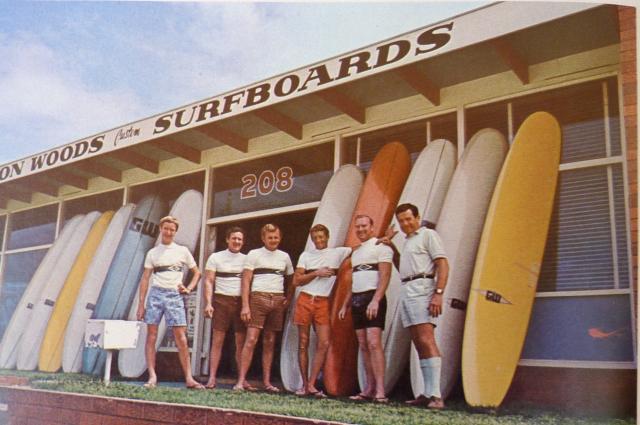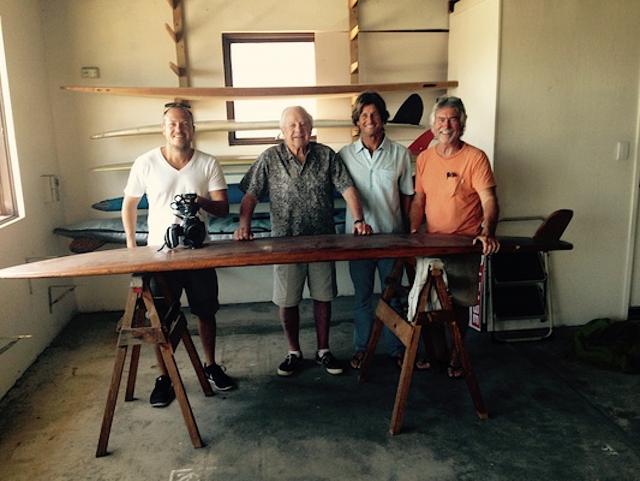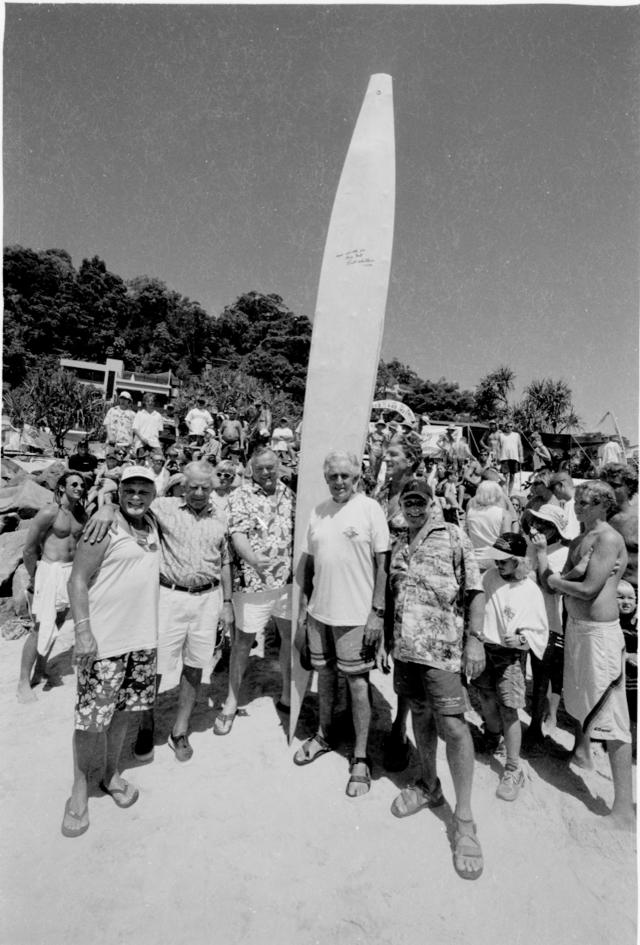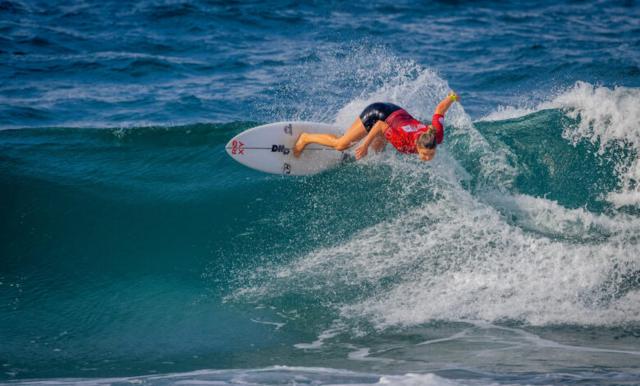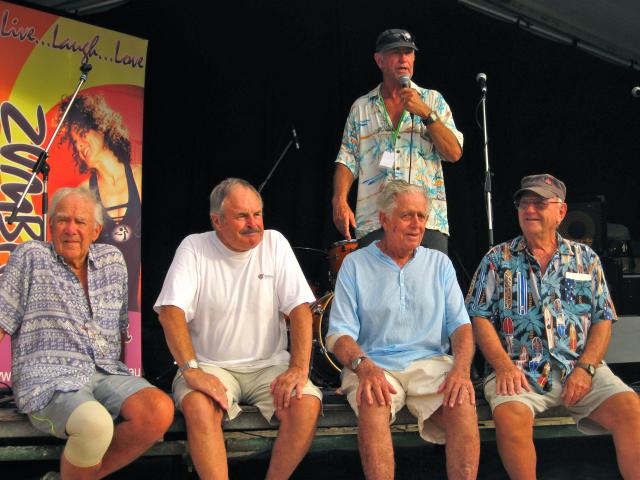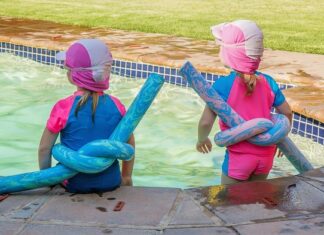My first impression of Gordon Woods, who died aged 98 earlier this month, was that he was a thorough gentleman. That was in 1965, when Gordon would have been 40 – around the same age my kids are now – and I felt the same about the man all the years I knew him, right into his nineties.
I’ll never forget that first meeting, because Woodsy looked exactly like he does in that famous advertising group shot from the mid-sixties where he’s standing with his shapers and glassers outside the Brookie showroom (obviously on a Saturday morning when they put the shop boards out front with a discount offer), looking like he’s just dropped into the factory to grab a wad of cash before hitting the golf course. Our first encounter was on just such a Saturday morning, a surf buddy’s older brother having driven us up from the ‘Gong so we could snare our first ever brand new surfboards at a bargain price.
We did a drive-by of all the big showrooms – Gordon Woods, Barry Bennett, Bill Wallace, Scott Dillon – before settling on Woods on Harbord Road because it seemed to offer a broader selection. As we approached the lawn in front of the board racks, the older brother whispered, “That’s him, that’s Gordon Woods!” Gordon Woods was old like my dad, but what distinguished him was his country club attire, collared golf shirt, Bermuda shorts and matching long socks, everything ironed including the socks, and polished brogues. Gordon Woods didn’t strike me as a surfer, but he was nice. He strolled over and said to the older brother, “Young chaps looking for a board?” He mussed my mate’s curly hair and gave me a pat on the shoulder. “Let’s see what we’ve got.”
We settled on a poo-brown Nat Young model for me, and Gordon gave me a good trade-in on my lime-green Norm Casey then dropped the price a little more to match the cash I had in an envelope. I was so stoked.
Gordon Woods was born in Sydney in 1925 and first took to the waves in a canvas-topped canoe as a teenager, but during the war years he started to make hollow, wood-framed “cigar boxes” for himself and a circle of friends around Bondi. Alongside Bill Wallace in Bronte, he found himself building paddleboards for surfers up and down the coast. By the mid-1950s he was in full production with supply contracts from surf clubs, but keen to improve his boards’ surfing performance for his own benefit, he kept refining his designs. Then in 1956 when the American and Hawaiian lifeguard team arrived en route to the Melbourne Olympics surf carnival at Torquay, Gordon could barely believe his eyes. The Yanks could corner along the wave face on their finned Malibu chip balsa boards, performing stunning tricks as they passed. It was incredible. It was a revolution.
Gordon cut a deal with lifeguard Bob Burnside to buy his Velzy pig model before he left the country, and followed him down to Torquay to make sure he kept his word. Unable to source enough balsa, Gordon and the other tyro surfer shapers who managed to score a template, made their early Malibu chips the way they’d made paddleboards – hollow with wood ply frames. But once balsa became available, followed soon after by foam, the surf boom was on, with most of the pioneers relocating to a former market garden on the northern beaches, where they became known as the “Brookvale Six”.
Throughout the sixties Gordon Woods led the industry, with Barry Bennett right on his heels. He had the best team riders and the best craftsmen, and he wasn’t slow to tell you he didn’t need to advertise, but he’d do so to help you out. When I renewed acquaintances with Gordon at Tracks magazine in the mid-1970s, he was already phasing out of surfboards to build yachts, but he never lost his passion for the sport and the industry.
When I set out to make a television documentary on the Brookvale Six and the birth of the surfboard industry, Gordon was my first port of call. This was eight years ago when he was a grom just 90 years young. I wrote then:
Gordon’s not as nimble as he once was since having a stroke, but after a three-hour interview in his penthouse apartment overlooking Sydney Heads, he thought we needed to visit his man-cave where he keeps the first finned surfboard made in Australia, back in December 1956. Keeping up with Gordon as he flashed through the back streets in his sporty car with personalised plates was not easy, but we made it to the cave in one piece, and he unveiled the hollow ply “okanui”, still in immaculate condition.
As we filmed him with the board, I suddenly realised that Gordon was buggered. “Do you need a breather, old mate?” I asked. “Perfectly fine,” he snapped, and continued posing with undisguised pride with his creation, the board that started it all nearly 60 years ago. That board was a copy of a red balsa board that Gordon had seen ridden at Manly by American lifeguard Bob Burnside, amazed by the way Burnside had turned the shorter (only 10 feet) and lightweight board with a big D-shaped fin across the wave and ridden diagonally to shore as he walked up and down the deck. That board became the template for the entire Australian surfboard industry.
With Gordon gone, we are down to the Brookvale One, Denny Keogh being the lone survivor.
Rest in peace, old mate. A life well lived.
FOOTNOTE: Margaret River’s Bronte Macaulay made a welcome return to form to win the Ballito Pro in South Africa at the weekend, rocketing her into fifth position in the WSL Challenger Series. San Clemente’s Cole Houshman won the men’s in a wave-starved final.

